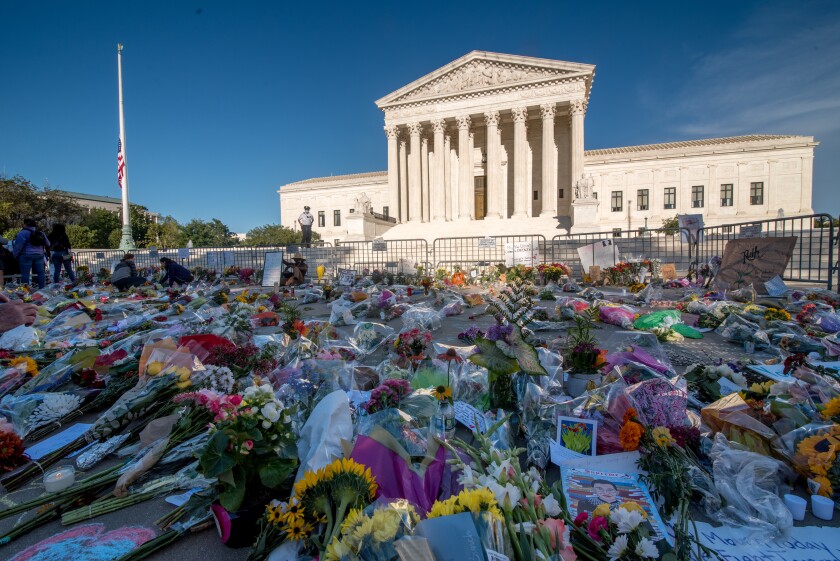Public respect for the U.S. Supreme Court has plummeted. A 2022 Pew Research poll indicates that only 39 percent of Republicans have a strongly favorable opinion of the court, and only 13 percent of Democrats. Independents give the court a 25 percent approval rating. In 1987, 80 percent of Republicans and 75 percent of Democrats had a high regard for the Supreme Court.

You can almost fix the moment when everything began to change. On Oct. 23, 1987, the United States Senate rejected the Supreme Court nomination of Robert Bork 58-42. The televised hearings were gripping. This was when most Americans realized that getting on the court had at least as much to do with politics as with judicial merit. Then there was the chaos of the Clarence Thomas nomination in 1991. He called the ordeal of his Senate confirmation hearings “a high-tech lynching.” Very, very strong words.
In a hearing chaired by then-Sen. Joe Biden, Supreme Court nominee Clarence Thomas critiqued the process as a "high-tech lynching."
Then the Senate’s refusal even to consider the nomination of Merrick Garland in 2016. Then the circus of Brent Kavanaugh’s nomination in 2018, during which both Kavanaugh and Sen. Lindsey Graham lost control of their emotions on national television.
More recently, several U.S. Supreme Court justices have come under a cloud of ethical impropriety: cozy land deals, what appear to be clear conflicts of interest, free million-dollar foreign vacations, spouses seeming to profit from their proximity to power, failures to disclose gifts and other emoluments, leaks and counter-leaks on the high court.
By now, we are more or less accustomed to such allegations with respect to Congress. But most Americans have been shocked and saddened to see the stink of corruption hover over the once-revered Supreme Court.
In short, the American people have good reasons for having lost respect for the Supreme Court.
The Inherent Problem of the Supreme Court

A CBS News retrospective on the 2000 presidential contest in which the Supreme Court ultimately affirmed George Bush's victory in Florida — by a margin of 537 votes.
They can decide the reproductive destiny of 170 million American women (Roe 1973, Dobbs 2022).

(Shutterstock)
In the course of American history, the Supreme Court has done some wonderful things to advance or protect the rights of the American people, but it has also made some colossal mistakes. There have been times when the court has misread the Constitution. And there have been times when the court has misread the country. Any objective study of the history of the Supreme Court reveals that it has more often sided with the forces of privilege and profit than with average Americans. It has often endorsed what we now regard as racial oppression and economic exploitation. It has been a friend to corporate capitalism.
The imperfections of judges and justices is something Thomas Jefferson understood from the beginning. He quoted the quip from the Roman poet Juvenal’sSatire VI: “Quis custodiet Ipsos custodes?” OK, we may need guardians, but who will guard us from our guardians? Jefferson understood that Supreme Court justices are men (and now women) like other men and women. They have good days and bad days. They have prejudices and biases. They have political leanings. They subscribe to transcendent moral codes that may cloud their judgment.
Why So Much Unchecked Power?
Why should the Supreme Court have such seemingly unlimited power? Answer: because every system where disputes arise needs a final arbiter, an umpire. Imagine a game of professional football in which the two teams had to decide between themselves whether one team had jumped offsides or if there had been pass interference. It’s amazing that when the stakes are extremely high — the Super Bowl, the NBA finals, the World Series — both sides “accept” the rulings of the referees, even when they think the refs got it wrong. In addition, professional sports leagues have bylaws which permit them to fine (or even suspend) players and coaches who publicly question the basic credibility of the referees.
Please excuse the sports analogies, but Chief Justice John Roberts started it! During his confirmation hearings in 2005, he declared that he intended to “call balls and strikes.” That is, he vowed to serve as an entirely neutral umpire and not to engage in policymaking from the bench. Balls and strikes. Whether he has actually lived up to that self-imposed standard is the subject of considerable debate.
We want a neutral referee, an uncorruptible umpire. If the umpire secretly favors the Mets and makes calls throughout the game that punish the Yankees, he destroys the legitimacy of a Mets victory. The system only works if the contestants and the viewers acknowledge that the umpire’s rulings were fair, even if he didn’t always side with my team.
The Supreme Court is the final arbiter of judicial disagreements in American life. But unlike the MLB, the NBA or the NFL, the court has no enforcement power.
The Fragility of the Court’s Authority

It can tell Topeka, Kan., to desegregate its schools, but if Topeka says, “The court has made its decision, now let it enforce it,” what’s the remedy?
Moral Authority
For this extremely delicate system to work, the American people have to “invest” the court with authority and moral credibility. The court’s credibility — in other words its authority — depends entirely on our belief that they are worthy of deciding momentous questions on our behalf. Because their authority comes from trust rather than political elections, to maintain that trust they must make responsible judicial decisions based on a close and careful reading of the Constitution. In other words, the American public must be able to see the constitutional logic of the court’s decisions.
The justices must lead exemplary public lives and now — thanks to our culture of intense 24-7-365 media scrutiny — unobjectionable private lives. They need to be “holier than Caesar’s wife,” above suspicion both in actual behavior and in public perception. They need to be exceedingly careful in their associations. They need to appear to be (and if possible actually be) strictly nonpartisan. They need to avoid conflict of interest or even the appearance of conflict of interest. Even though they are inherently privileged (most justices have been educated at a handful of the most prestigious American universities), they must make it clear to the rest of us that they are not puppets of privilege and wealth.
This is a tall order. But if we relax these standards and just put ambitious and well-schooled people on the court, without holding them to the highest standards of American life, millions of honest Americans will have reason to doubt — and even reject — their decisions. The Supreme Court needs to be the class act of the American constitutional system.
The Emperor Has No Robes
It’s tempting to think about Supreme Court justices as if they walked straight out of Plato’s Republic. In other words, that they were wise men and women of spotless integrity, inherently cautious, with a strong devotion to the principle that every American has equal status under the law, dedicated only to protecting the Constitution and the Bill of Rights, with no prejudices or biases of any sort. Wouldn’t that be lovely? But we live in the real world, not Plato’s utopia, and there is now a widespread public perception that the court has become dangerously more political in recent years and that — in some cases — it appears to throw off any pretense to objectivity altogether.
Giving nine unelected and unimpeachable individuals life tenure with no subsequent votes of confidence or no confidence is a mighty grave thing to do. There has never been a successful impeachment of a Supreme Court justice. Given the longevity of privileged men and women today, we can expect some Supreme Court justices to serve for 40 years, maybe even for 50 years, before they die in office or retire. That’s an enormous amount of power for an enormous amount of time. Once they are confirmed by the U.S. Senate, there is no controlling them. No accountability.
Everyone understands why there needs to be substantial independence in the court. If we elected justices, the third branch of the national government would be just as political as the other two. The Founders understood that some questions should not be resolved politically. They intended the Supreme Court to stand outside the political arena and to be as immune from routine politics as possible. That’s why justices aren’t elected, and why they get life tenure. A majority of Americans — even a supermajority — cannot eviscerate the First Amendment’s protection of freedom of expression and freedom of religion. Even if 90 percent of the American people wanted to shut down The New York Times in wartime, the court should stand bravely behind the First Amendment, however unpopular that made the justices.
That’s the theory. But many Americans now believe that the third branch is political. It is well known that Chief Justice Roberts is concerned about the court’s loss of prestige and loss of credibility. The party-line vote in Bush v. Gore at the turn of the century didn’t help. The Dobbs decision last year appeared to many not only to be a strictly partisan vote (Republican appointed justices voted to overturn Roe, Democrats to uphold it), but to be the work of six Catholic justices — in a nation that decided early to separate church and state.
At a time when the American people have lost confidence in most of our public institutions, we desperately need the Supreme Court to be an institution — and a group of individuals — we can wholeheartedly respect, even revere.
Listen and subscribe to the audio version of this and other essays in the series from the Future in Context podcast using the player above or on Apple Podcasts, Google Podcasts, Stitcheror Audible. Clay welcomes your comments and critiques of his essays and interviews. You can reach him directly by writing cjenkinson@governing.com or tweeting @ClayJenkinson.
Related Articles














